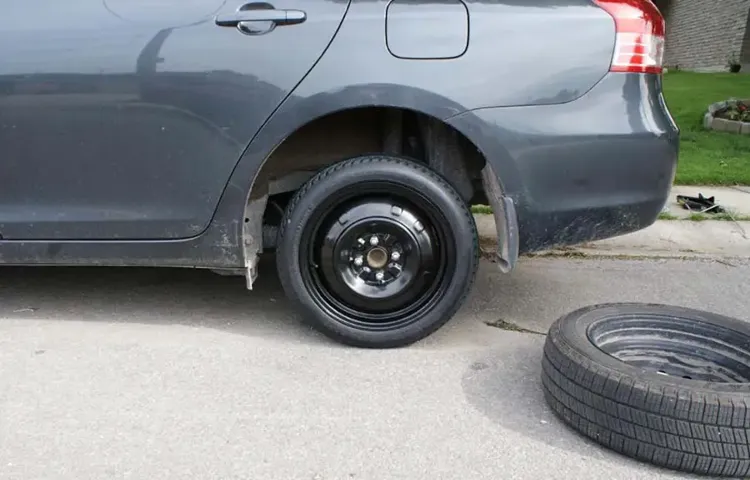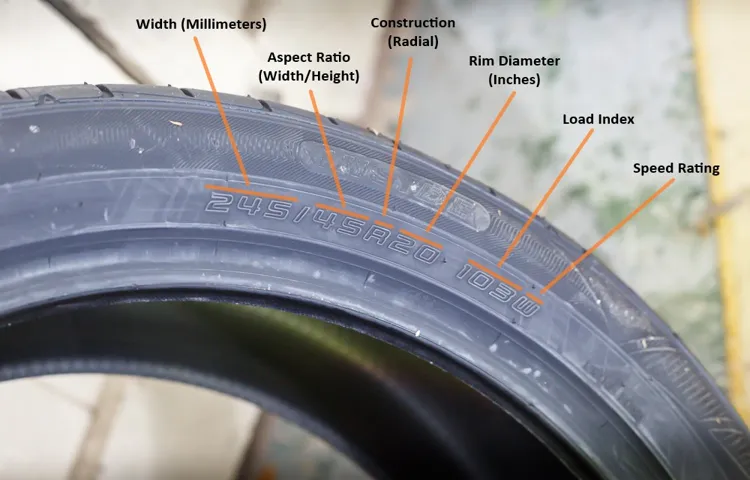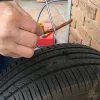Have you ever found yourself in a sticky situation with a flat tire and a donut spare tire that needs air? It’s a common scenario that can cause frustration and confusion. One of the most common questions people ask is, “how much air is needed in a donut spare tire?” After all, the last thing you want is to overinflate or underinflate your tire, leading to further problems down the road. In this blog post, we’ll explore the ins and outs of donut spare tires and provide all the information you need to inflate your tire properly.
So, buckle up and let’s dive in!
Table of Contents
Understanding Donut Spare Tires
If you have ever been in a situation where you have had to use a donut spare tire, knowing how much air should be in it is crucial. Typically, donut spare tires require a higher inflation pressure than regular tires due to their design and smaller size. The recommended tire pressure for a donut spare tire can vary depending on the make and model of your vehicle, so it is important to consult your owner’s manual for the specific inflation pressure.
In general, the recommended tire pressure for a donut spare tire can range from 60 psi to 90 psi. However, it is best to check the tire’s sidewall for the correct tire pressure rating. It is important to note that donut spare tires are meant for temporary use and should not be driven on for extended periods or long distances.
It is recommended to replace the donut spare tire with a regular tire as soon as possible and to have the tire repaired or replaced if it has been used.
What are donut tires and how are they different from regular tires?
Donut spare tires are a type of temporary tire that comes with most modern cars. These tires are known for their smaller size, lighter weight, and narrow width compared to regular tires. They are typically used as a quick replacement for a flat tire and are intended to be used for a limited distance and at a reduced speed.
Donut tires are designed to take up less space in the trunk, making them easier to store and transport. However, they have some limitations when it comes to handling, stability, and durability. Unlike regular tires, donut tires cannot be driven long distances or used in extreme weather conditions.
It’s important to note that donut tires are a temporary solution and should only be used as a last resort until a permanent tire replacement can be made.

When are donut tires used?
Donut tires, also known as space saver tires, are used as a temporary solution when a regular tire is damaged or punctured. They are smaller and thinner than regular tires, and often have a distinctive tread pattern. These types of tires are designed to be used for short distances and at lower speeds, typically no more than 50 miles per hour.
Donut tires are often found in the trunk of cars, and can be easily swapped in a few minutes. They are particularly useful in emergency situations, where replacing a tire isn’t immediately possible. However, it’s important to note that donut tires are not meant to be used for extended periods of time, and should be replaced with a regular tire as soon as possible.
Overall, donut tires are a reliable backup solution that can provide a sense of security in case of a tire emergency.
Determining the Correct Air Pressure
When it comes to determining the correct air pressure for a donut tire, it’s important to refer to the manufacturer’s recommendations to ensure safe driving conditions. Usually, donut tires are designed to be used temporarily until the regular tire is repaired or replaced. Therefore, they require higher air pressure than ordinary tires.
Typically, the recommended air pressure for donut tires is around 60 PSI (pounds per square inch), but it may vary depending on the size of the tire and the weight of the vehicle. It’s important to check the donut tire’s sidewall for the recommended air pressure and inflate it accordingly with a tire inflator. Underinflated donut tires can cause handling problems and affect the vehicle’s stability, while overinflated tires can lead to blowouts or tread separation.
So, it’s crucial to follow the guidelines and ensure that donut tires are inflated with the right amount of air pressure to ensure safe driving until you can get the regular tire fixed or replaced.
Locating the recommended air pressure for your donut spare tire
When it comes to your donut spare tire, it’s crucial to know how much air pressure it needs. The recommended air pressure for a donut spare tire can be located in several places. Firstly, it might be listed in the owner’s manual of your vehicle.
The manual should have a section dedicated to tire maintenance and will provide you with information on tire inflation. Additionally, the tire itself may have the recommended pressure imprinted on its sidewall. Look for a label or stamp that might read “max psi” or “recommended pressure.
” If all else fails, you can always contact your local tire dealer and ask for assistance in determining the correct air pressure for your spare tire. Remember, it’s important to keep your donut spare tire inflated to the recommended air pressure as an underinflated tire can affect your vehicle’s handling and overall safety on the road.
How much air pressure should be added if the tire is underinflated?
When it comes to determining the correct air pressure for your tires, there are a few things to consider. First, you will want to consult your vehicle owner’s manual or the sticker located on the inside of the driver’s side door to find the recommended air pressure for your specific make and model of car. If you find that your tire is underinflated, it is important to add the appropriate amount of air pressure to avoid further damage to your tire.
Typically, if your tire is underinflated by about 5 PSI, you should add approximately 1 PSI of air pressure. However, it is important to note that this can vary depending on the size and type of tire you have, as well as the weight of your vehicle. By properly inflating your tires, you can improve your car’s handling, fuel efficiency, and overall safety on the road.
So, next time you check your tire pressure, be sure to add the appropriate amount of air to keep yourself and your passengers safe on the road.
How to check the air pressure in your donut spare tire?
Checking the air pressure in your donut spare tire is an essential part of maintaining a safe vehicle. The correct air pressure for your spare tire can be found in your owner’s manual or on the tire itself. It’s crucial not to overinflate or underinflate your tire; this can cause handling issues and potentially lead to a blowout.
To check the air pressure in your donut spare tire, you’ll need a tire pressure gauge. Remove the hubcap or wheel cover and locate the valve stem on your spare tire. Press the gauge onto the valve stem and wait for the reading.
If the reading is below the recommended pressure, add air until you reach the correct pressure. If the reading is above the recommended level, let some air out until you reach the proper inflation. Remember to check the air pressure in your donut spare tire every six months or before any long trips to ensure safe driving conditions.
Keeping a spare tire properly inflated can prevent a roadside emergency and keep you on the road longer.
Why Proper Inflation is Important for Donut Spare Tires
As a driver, you hope you’ll never have to use your donut spare tire, but it’s always a good idea to be prepared. Donut spare tires, also known as space-saver spares, are designed to be a temporary fix until you can get a proper tire replacement. They’re smaller and lighter than regular tires, which makes them easier to store in your vehicle.
However, their unique design means that they require more maintenance than regular tires. It’s essential to ensure that your donut tire is properly inflated before using it. The recommended inflation pressure can vary depending on the manufacturer and the size of the tire.
Typically, donut spare tires require a higher PSI than regular tires. You can find the correct PSI for your donut tire in your vehicle owner’s manual or on the tire’s sidewall. Remember, driving on an underinflated donut tire can cause it to overheat, leading to the tire blowing out.
On the flip side, overinflated tires can be just as dangerous, as they can cause the tire to burst while in use. So, how much air should be in a donut tire? It is recommended to keep the tire inflated to the manufacturer’s recommended PSI, to ensure optimal safety and performance on the road.
Safety concerns when driving on a donut spare tire
Proper Inflation for Donut Spare Tires When it comes to driving on a donut spare tire, safety should always be the top priority. As these tires are designed to be used for temporary purposes, they come with various limitations that can impact the driving experience. One of the most important aspects to consider is the tire’s inflation level.
It is crucial to ensure that the donut spare tire is inflated to the manufacturer’s recommended pressure, as driving on an underinflated tire can damage both the tire itself and the car’s suspension system. Conversely, an overinflated tire can cause instability on the road and make it harder to control the car. In either case, the risk of a blowout or losing control of the car greatly increases.
Therefore, it is important to check the inflation level of the donut spare tire regularly and adjust it as needed. By doing so, drivers can ensure their safety and prevent any additional damage to their vehicle.
Impact of underinflation on the performance and lifespan of the tire
Proper Inflation, Donut Spare Tire Proper inflation is crucial for the performance and lifespan of your donut spare tire. Underinflation can significantly impact the tire’s ability to function correctly, leading to several issues. Firstly, underinflated tires can cause decreased fuel efficiency, costing you more money in the long run.
Secondly, underinflated tires can overheat, causing blowouts, punctures, and other hazardous situations. Furthermore, underinflated tires wear out more quickly, causing damage to the tire’s structure and increasing the chances of an accident. Therefore, it’s vital not to ignore and closely monitor your donut spare tire’s inflation levels to ensure your safety and extend the tire’s lifespan.
Pro-tip: Carry a portable air compressor kit in your vehicle for an emergency to quickly inflate your tire to the proper PSI level when needed. Remember, properly inflated tires make for a safer, more efficient, and smoother driving experience.
Conclusion
In the grand scheme of things, the amount of air needed in a donut tire may seem trivial, but when you’re stranded on the side of the road with a flat tire, it suddenly becomes the most important thing in the world. So, to answer the question of how much air is needed in a donut tire, the answer is simple: enough to get you where you need to go. And if all else fails, just remember the wise words of Dorothy Gale, “There’s no place like home.
“
FAQs
What is a donut tire and how does it differ from a regular tire?
A donut tire (also known as a space-saver tire) is a smaller, temporary spare tire that is typically included in a car’s trunk. It is designed to be used as a short-term solution for getting a driver to a repair shop to replace a flat tire. The biggest difference between a donut tire and a regular tire is that the former is significantly smaller and not meant for long-term use.
How much air pressure should you put in a donut tire?
The amount of air pressure that you should put in a donut tire can vary depending on the specific tire and car manufacturer. However, a general rule of thumb is to inflate the donut tire to the recommended pressure listed on the tire itself. This is usually around 60 PSI.
Can you drive on a donut tire for long distances?
No, donut tires are not designed for long-term use and should only be used as a temporary solution to get to a repair shop to replace a flat tire. In fact, many car manufacturers recommend that you not drive on a donut tire for more than 50-70 miles.
How long can a donut tire last?
Donut tires are not designed for long-term use and typically do not last as long as regular tires. They are generally meant to be used as a temporary solution for up to 50-70 miles to get a driver to a repair shop to replace the flat tire.
Can you replace a regular tire with a donut tire?
Technically, you can replace a regular tire with a donut tire, but it is not recommended for long-term use. Donut tires are not designed to handle the same as regular tires and can affect the handling and stability of the car. It is recommended to replace a flat tire with a regular tire as soon as possible.
How do you change a tire and replace it with a donut tire?
To change a tire and replace it with a donut tire, you will need to jack up the car, remove the flat tire, and replace it with the donut tire. It is important to follow the specific instructions and safety guidelines provided by the car manufacturer in the owner’s manual.
Can you repair a donut tire?
Technically, yes, you can repair a donut tire if the damage is repairable. However, it is not recommended due to the short-term nature of donut tires. It is generally more cost-effective and safer to simply replace the donut tire with a regular tire.



